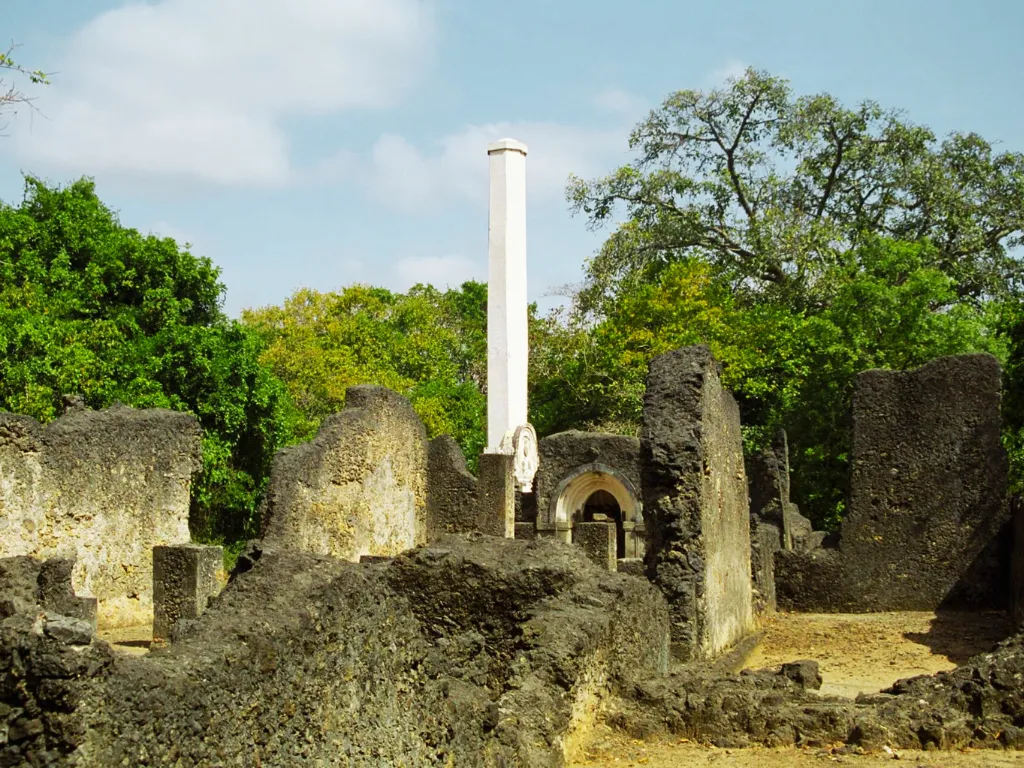

Why Visit? The Mnarani Ruins stand as silent sentinels of a bygone Swahili civilization. These remnants of an ancient coastal settlement whisper tales of commerce, conquest, and cultural fusion between Africa, the Middle East, and Asia. Dating back to the 14th century, the site features the crumbling remains of grand mosques and tombs, shaded beneath the embrace of towering baobab trees.
The site boasts the ruins of two ancient mosques—one of which retains remnants of its intricately carved mihrab.
The stone pillar tombs, adorned with elaborate inscriptions, are among the finest examples of medieval Swahili funerary architecture.
Towering centuries-old baobab trees dominate the landscape, their gnarled roots entwined with history.
The elevated location offers sweeping views of the azure Indian Ocean, enhancing the site’s tranquil and mystical ambiance.
Mnarani, meaning “place of minarets” in Swahili, once flourished as a coastal town deeply engaged in trade and Islamic scholarship. Established in the 14th century, it became a thriving node along the East African coast, frequented by merchants and scholars from Arabia and Persia.
By the 17th century, however, Mnarani met its decline, likely due to local conflicts and Portuguese incursions that destabilized many Swahili city-states. Today, what remains is an evocative testament to the once-prosperous Swahili civilization.
Visiting Hours: Open daily from morning to evening, though exact timings may vary.
Admission: Modest entrance fees apply, with discounts for students and groups.
Location & Access: Easily accessible from Kilifi town, about 56 km north of Mombasa along the Mombasa-Malindi highway.
Cultural Heritage Tours: Knowledgeable guides provide insight into the history and significance of the ruins.
School & Research Visits: The site is popular among historians, archaeologists, and students of Swahili culture.
Photography & Meditation Retreats: With its serene setting and stunning backdrops, Mnarani is a haven for photographers and those seeking quiet reflection.
Guided Tours: Available upon request at the entrance.
Seating Areas: Rest stops provided under the shade of baobab trees.
Nearby Cafés & Accommodations: Kilifi town offers dining and lodging options within a short drive.
Respect the Site: As a protected historical monument, refrain from touching fragile structures.
Dress Comfortably: The coastal climate can be warm—light clothing and comfortable shoes are recommended.
Combine with Other Attractions: Consider pairing your visit with a trip to the Kilifi Creek or nearby Gede Ruins for a fuller historical experience.
Wander the Mnarani Ruins and listen closely—the whispers of the past still rustle through the ancient stones, carried by the ocean breeze, beckoning the curious traveler to uncover the secrets of a lost civilization.
The National Museums of Kenya (NMK), established under the Museums and Heritage Act (2006), is a multi-disciplinary institution dedicated to collecting, preserving, researching, and presenting Kenya’s cultural and natural heritage.
Sign up to our newsletter